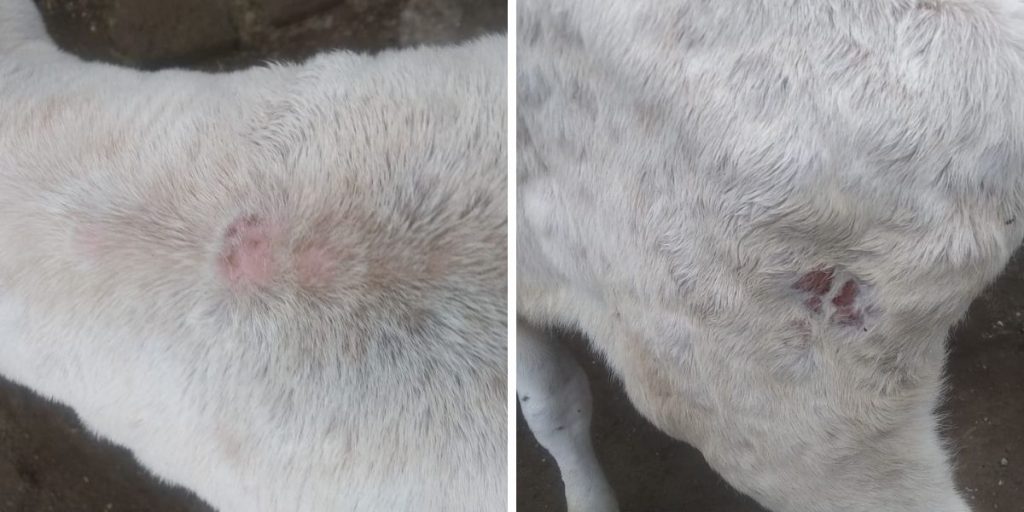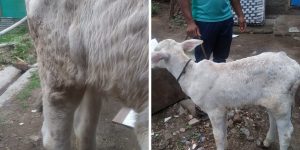
An Incidence of Lumpy Skin Disease in 20 Days Old Cow Calf
An incidence of Lumpy Skin Disease was noticed in 20 days old khillar male calf. The calf showed symptoms of fever, salivation, nasal and eye discharge, nodular, hard and painful swelling on all over the body and some ulcerative lesions on the skin was also noticed.
 The Lumpy Skin Disease is a viral disease in cattle. It is closely related to the poxvirus of sheep and goats. The disease is host-specific and causes prolonged morbidity. Generally, younger animals are more severely affected. The disease occurs in warm and wet climates. The virus can survive in desiccated crust for up to 35 days and18 days in air-dried hides. The disease initially occurred in Africa, further it spread in middle east, Asia, eastern Europe, China and India. In India, the disease first time appeared in the year 2019.
The Lumpy Skin Disease is a viral disease in cattle. It is closely related to the poxvirus of sheep and goats. The disease is host-specific and causes prolonged morbidity. Generally, younger animals are more severely affected. The disease occurs in warm and wet climates. The virus can survive in desiccated crust for up to 35 days and18 days in air-dried hides. The disease initially occurred in Africa, further it spread in middle east, Asia, eastern Europe, China and India. In India, the disease first time appeared in the year 2019.
Cause of disease: Lumpy Skin Disease Virus of genus Capripoxvirus within family Poxviridae.
Spread of the disease: Lumpy Skin Disease spreads in animals by biting insects such as mosquitoes and biting flies. The virus may spread by direct contact to the skin lesions, saliva, nasal discharge, milk and semen of infected animals.
Clinical Findings: Fever, salivation, discharge from eyes and nose, weight loss, drop in milk production, few or multiple hard and painful nodules appear on all over the body. Skin lesions may persist for several days or months. Regional lymph nodes are swollen and sometimes oedema may develop around udder and brisket regions. In some cases it may cause lameness, mastitis, pneumonia, abortion and sterility in male and females.

Biochemistry: Lowered WBC and platelets, erythrocytosis, elevated protein and globulin level, reduced albumin and glucose level etc.
Specimen required for Laboratory Examination: Blood and tissue samples from skin lesions.
Laboratory Tests for Diagnosis: Antibody detection test, virus neutrilization test, ELISA, PCR and RT_PCR techniques.
Diagnosis: Not difficult to diagnose based on typical symptoms. It needs to be differentiated from cow pox, whose lesions are restricted to non-hairy parts of udder and teat. Confirmation by laboratory rests.
 Lumpy Skin Disease Treatment:
Lumpy Skin Disease Treatment:
As it is a viral infection no treatment, but to avoid secondary bacterial infections antibiotics, anti-inflammatory and antihistaminic medications are given. Lesions of skin may be treated with antiseptic solutions as lumpy skin disease virus killed by 2% sodium hydroxide, 4% sodium carbonate and 2% formalin. Ascorbic acid 10% is rated as the best but the problem is that aqueous ascorbic acid is not stable hence must be prepared fresh.
Prevention and Control: Improve management practices.
- Adopt strict biosecurity measures on the farm and premises
- New animals should be kept in quarantine and examined for skin nodules and lesions.
- Avoid movements of animals from affected area
- The affected animal should be kept separately from the herd along with feeding, watering and treatment, such animal should not be allowed on common grazing areas.
- Control of biting mosquitoes and flies by using proper insecticides. Similarly use vector repellents regularly, which will minimise the risk of vector transmission.
- Limit the vector breeding sites nearby the farm which requires better manure management.
- Vaccine – A Freeze-dried, live attenuated vaccine is available which helps to control and spread of the disease. Vaccinate the remaining animals as per manufacturers’ instructions.
(Please also read a blog on the Lumpy Skin Disease in Cattle by the different author)
You may like to read: Flies in the Farm? Your Cows May Have This Disease
| Dr. V. M. Bhuktar
Former I/c Joint Commissioner A. H. Western Regional Disease Diagnostic Laboratory (WRDDL) Pune M.S |
Dr. Harischandra J. Abhyankar
Livestock Development Officer (extension) |
